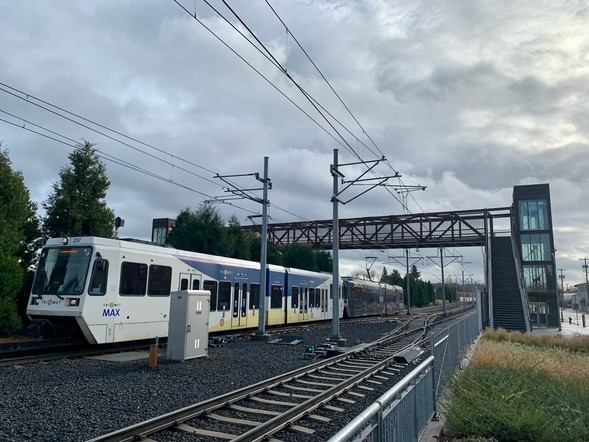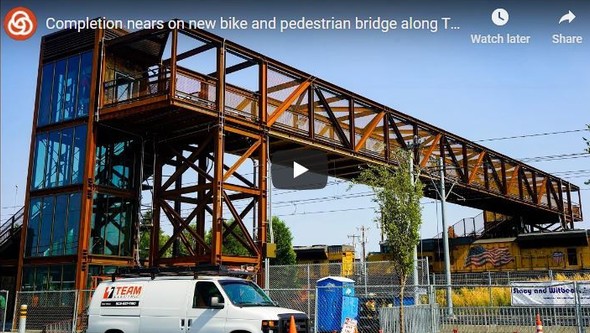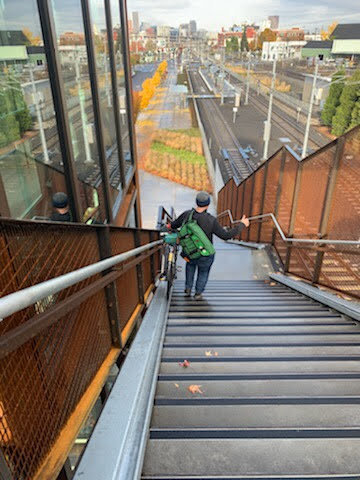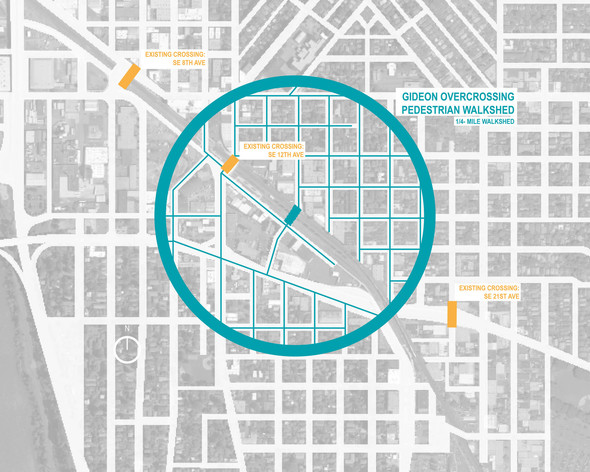 News Media contact:
Dylan Rivera
(503) 577-7534
dylan.rivera@portlandoregon.gov
@pbotinfo
News Release:
New bike & pedestrian bridge provides safer rail crossing along MAX Orange Line and freight rail tracks in SE Portland
 The Gideon Overcrossing bridge opened this morning, providing up a new, safer and more convenient way for people to bike, walk or roll across the rail tracks for the MAX Orange Line and Union Pacific Railroad in SE Portland. People biking or walking who are stopped by trains at SE 11th and 12th avenues can now get around with this nearby bridge. Photo by Caitlin Reff / Portland Bureau of Transportation.
(Nov. 10, 2020) A new bridge opens today in Southeast Portland, designed to provide a safe, convenient way for people biking, walking, or using a mobility device to cross the MAX Orange Line and Union Pacific Railroad.
The Gideon Overcrossing, named for a nearby street, takes travelers from SE 14th Avenue north of the tracks to SE 13th Place at Gideon Street, near the Clinton St / SE 12th Ave MAX Station, on the south side. The new bridge provides a north-south connection above the busy rail lines.
TriMet worked alongside the Portland Bureau of Transportation (PBOT) to develop the bridge. Now that the bridge is open, TriMet will hand it off to PBOT, which will then own, operate, and maintain it.
"This new bridge makes it safer and more convenient than ever to bike and walk through Southeast Portland across the MAX Orange Line and the railroad tracks," PBOT Director Chris Warner said. "Thanks to our partnership with TriMet and area residents, we are able to make a crossing that will help people incorporate biking, walking, and public transit in their everyday lives. It takes years to make large projects happen, and a crucial piece of the MAX Orange Line is finally in place."
“The new Gideon Overcrossing is the end result of years of collaboration between TriMet, PBOT, the adjacent neighborhoods and others to fulfill a need—provide a safer, more convenient way for pedestrians and cyclists to cross heavy rail tracks,” TriMet General Manager Doug Kelsey said. “With its proximity to both a MAX light rail station and a bustling neighborhood greenway, this crossing creates yet another connection in Southeast Portland, one that will help visitors and neighbors alike move more freely.”
Located two blocks from the Clinton Neighborhood Greenway, the bridge enhances the connection from the Hosford-Abernethy neighborhood to the Willamette River, completing the vision of the city’s “Clinton to the River” project.
Its proximity to the light rail station, which is approximately 300 feet to the west, makes it an attractive option for crossing the rails. It replaced an older bridge that was removed to make way for the MAX line.
This bridge is the final piece of the MAX Orange Line, which opened in September 2015.
The $15 million bridge was deferred during the development of the Portland-Milwaukie Light Rail Project (which built the MAX Orange Line) in 2010. But with the strong support of PBOT, federal partners, and community members, TriMet successfully secured approval from the Federal Transit Administration (FTA) to construct the bridge using some of the remaining funds from the MAX project.
TriMet VIDEO: Learn more about this new bridge, directly from an area resident and one of the TriMet experts who helped build it
 PBOT and TriMet worked closely with the project contractor, Stacy and Witbeck, and the surrounding community to keep the project moving along safely throughout the spring and summer months.
Through it all, the project moved along during the summer as construction picked up, including the installation of elevator equipment and cyclist-friendly stairways featuring bike gutters at both ends of the bridge. Bike gutters are metal channels running alongside stairs, with a downward-dipping groove for a bike’s tires, which let cyclists easily walk their bikes up and down.
The bike gutters are a unique design and a first for Portland. The design was based on experience locally, and studies of what works and doesn’t work worldwide. The Gideon bike gutters were designed to prevent problems experienced elsewhere such as bikes hitting the handrails because the angle is bad, or gutters that couldn't fit certain wheel sizes or types.
 One of the first people using the bike gutter on the new Gideon Overcrossing bridge signals their approval after the bridge opened this morning. Photo by Caitlin Reff / Portland Bureau of Transportation.
Overall, the bridge will be fully compliant with the Americans with Disabilities Act, featuring elevators large enough to accommodate mobility devices.
The elevators also are large enough to accommodate bicycles with a trailer or child’s tag-along attachment. The pass-through elevators allow people to enter on one side and exit on the other side. This avoids the need to go backwards or turn around, with a mobility device or a large bicycle.
The bridge is located strategically to serve the needs of travelers in the area by addressing a gap in the transportation network. People walking or biking who are stopped at the rail crossing at SE 11th and 12th Avenues will find the new bridge close by, accessible by passing along a wide sidewalk and low-traffic street south of the tracks.
When traveling from the Brooklyn neighborhood south of SE Powell Boulevard, someone walking or biking who uses a marked crosswalk at SE 13th Place would have a direct route to the bridge. A bike and pedestrian crossing over SE Powell at SE 16th Avenue also leads directly to the bridge.
 This map shows how the location of the Gideon Overcrossing, in blue at the center of the circle, provides a safe, convenient crossing over railroad tracks. When trains block traffic at SE 11th and 12th avenues, the new bridge will be the most accessible way to cross the rails. Map by PBOT.
The bridge is located entirely within city right-of-way to minimize the impact to neighboring businesses, including those located on SE 14th Avenue.
Learn more about the Gideon Overcrossing with this recent TriMet blog post
The Portland Bureau of Transportation (PBOT) is the steward of the city’s transportation system, and a community partner in shaping a livable city. We plan, build, manage, and maintain an effective and safe transportation system that provides access and mobility. www.portlandoregon.gov/transportation
|